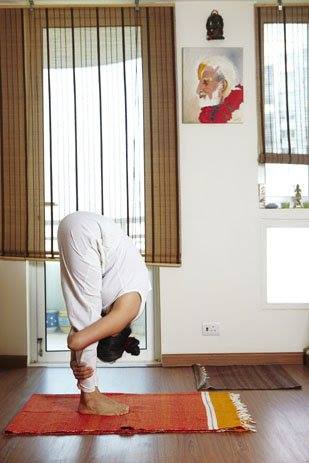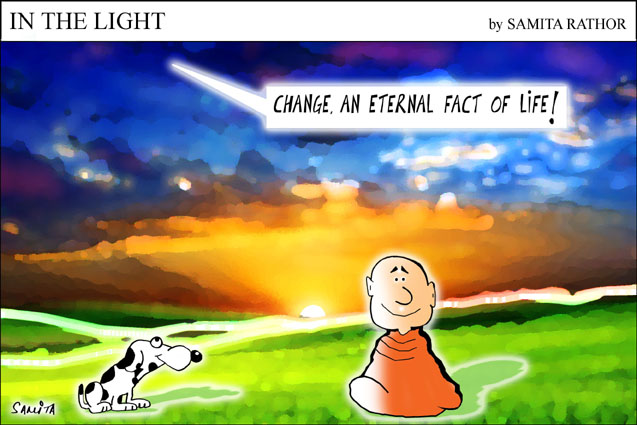"Yoga serves the individual, and does so through inviting transformation rather than by giving information." T.K.V. Desikachar
The mention of the word Parinama comes in SADHANAPADAH 2.15 as one of the causes for dukha.
2.15 Parinama tapa samskaradukhaih gunavrittivirodhacca dukhameva sarvam vivekinah
According to a viveki (discriminatory knowledge) the world is full of dukha (suffering) due to Parinama (change), samskara (conditioning), tapa (craving) and guna vritti (movement in the gunas). The background of every spiritual teaching is to get out of dukha. If we get out of suffering dukha ends and that in itself is Parinama.
Change in place, change in relationship, change in relationship can cause dukha.
According to the Kapila’s Samkhya philosophy there are 3 causes for suffering
Ahdyatmika-caused by self
Adhibhoutika-caused from the bhutas. E.g. a snake bite.
Adhidaivika-caused from supernatural forces. E.g. tsunami or floods.
In VIBHUTIPADAH SUTRAS 3.9 - 3.16 talk about the 3 Parinama
3.9 Vyutthananirodhasamskarayoh abhibhavapradurbhavau nirodhaksanacittanvayo nirodhaparinamah
The samskaras of one who is in a state of vyutthana(coming out), when he is trying to be in command of the thought waves as they appear and disappear, then the mind connects with the moment it is a Nirodha Parinama.
How does one get Nirodha Parinama?
After continuous practice and lot of effort one gets the power to be in command of the mind. The moment the samskaras accumulate during vyutthana state, the practitioner is able to recognize them. The connection of the mind at this moment is Nirodha Parinama.
The samskaras are the characteristics of the mind. The Parinama of samskaras are taking place in us every moment.
According to Sri Desikachar-“the mind is capable of 2 states based on 2 different tendencies. These are distraction and attention. However at anyone moment only one state prevails and this state influences the individual’s behavior attitudes and expressions.”
3.10 Tasya prasantavahita samskarat
Fruits of Nirodha Parinama
When the habit of restraint and nirodha is formed there is effortless flow of peace tranquil and spontaneous flow of movement of nirodha where the thought waves have restrained themselves.
3.11 Sarvatataikagratayoh ksayodayau cittasya samadiparinamah
When all pointedness of the mind subsides and one pointedness rises it is called Samadhi Parinama. The nature of the mind is sarvart (all pointed). It can be made one pointed and when this is done there is an inclination towards Samadhi. A mind in ekagrata itself is a Parinama.
3.12 tatah punah santoditau tulyapratyayau cittasya ekagrataparinamah
When the mind is no more bothered when the thought waves rise or subside and is being able to concentrate on one single point it is called Ekagrata Parinama.
We all have a state of shanta (undisturbed/down) and udita disturbed (up) mind. When it is in a state of balance there is one pointedness.
How can we visualize these 2 different states of shanta and udita?
Pranayama and abhyasa helps us visualize shanta and udita. Only in a state of santa we can reflect on an object .It is a state of no thought waves.
3.13 Etena bhutendriyesu dharma lasksana avastha parinamah vyakhyatah
The dharma, laksana and avastha can change. Kala brings change.
Parinama can be divided as
1. Dharma (properties) gets influenced by the 3 gunas and food. Astanga yoga, diet and moderate activity are the factors.
2. Laksana (character) gets influenced by external factors like sangha.
3. Avastha(condition) which gets influenced by kala and factors like which stage of life one is in. One’s activity should synchronize with kala.
3.14 A dharmi who possesses dharma may have characteristics that may be (santa) dormant), udita (arisen) or avyapadeshya (manifested). Dharmi does not undergo any change.
3.15 The dharma possessing different characteristics in the (santa) dormant), udita (arisen) or avyapadeshya (manifested) is the cause of the different modifications of the thought waves.
3.16 If we practice dharma, laksana, avastha and samyama then one can get past knowledge and what is going to happen in the future.
KAIVALYAPADAH 4.12-4.15 talks about the Concept of Parinama
4.12 Atitanagatam svarupatatah asti adhvabhedaddamanam
Whatever will appear in the future or has appeared in the past is essentially in a dormant state. What is past has not disappeared forever.
The substance of what has disappeared as well as what may appear always exists. Whether or not they are evident depends upon the direction of change. the past existed as past and also the future. Objects and events are closely related. Without any object there are no events. Past seems like imagination but it does exist. Past and future is not a fabrication of the mind. Sat karya vada.The world is real and exists but it is subject to change. Consciousness and matter exists. It is neither created nor destroyed. It undergoes change continuously. Creation is nothing but change.
4.13 Te vyaktasuksmah gunatmanah
Objects make events. All objects are made of 3 gunas. These are sometimes fully blown and sometimes subtle.
4.14 Parinamaikatvat vastutattvam
The raw material of objects are the 3 gunas. Difference in these objects is merely a difference in the combination of the gunas.
4.15 Vastusamye cittabhedat tayorvibhaktahpanthah.
Objects are always the same but perceived by different mind in different ways. Sri Desikachar gives an example how a Hindu temple is a place of worship to the devoted believer, an artistic monument to the tourist, a place of solicitation to the beggar and even a place of ridicule to atheist. This is a very important sutra for personal relationship. We always find fault in others. Allow the other persons opinion to be heard by you.
4.32 Tatah krtarthanam parinamakramasamaptigunananam
Our activities are nothing but combination of the gunas. Gunas are controlled by samskaras. At this stage the gunas totally cease.
4.33 Ksanapratiyogi parinamaparanta nirgrahyah kramah
Parinama is a quality in prakriti based on a particular karma. Citta vrittis and gunas are going away here as is no samskaras. Klesas become inactive. Parinama comes to an end. Citta vritii nirodha.
SOME IDEAS ABOUT PARINAMA
· Parinama is one of the most important concepts in the Yoga Sutra of Patanjali.
· It means change from the philosophical and practical point of view.
· The concept of Parinama is not just for the mind but also the bhutas (elements) and indriyas (senses).
· How the universe came into existence is due to Parinama. The universe is constantly going through changes.
· Parinama is present in Prakriti which is always changing due to the presence of the 3 gunas rajas, tamas and satva.
· It is a key-concept in the Samkhya philosophy on which Patañjali's Yoga Sutras are based, and also in the philosophy of the Vedanta. It is a key concept, because, Samkhya or Yoga thought in Indian philosophy is classified as 'parinama-vada' or also 'satkaryavada'.
· Samkhya and Yoga believe, that when e.g. a tree grows out of a tiny seed, this proves that this mighty tree must already have been present in the seed, be it in a hidden way. For the tree cannot emerge out of nothing. In the same way the whole visible world must have emerged out of a world-seed, in which it existed in a non-manifest way before it appeared.
· In Yoga and Samkhya the whole of life is a projection of something that lies hidden deep inside.
“The Mastery of Yoga must not be measured simply by the ability to master the techniques of yoga like asana and pranayama, but by how it influences our day-to-day living, how it enhances our relationship and how it promotes clarity and peace of mind.”
T K V Desikachar








































